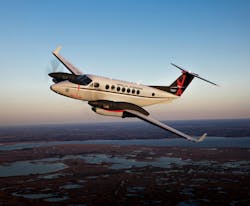FAA seeks advanced Beechcraft 360ER flight simulator for pilot and inspector training
Questions and answers:
What type of simulator is the FAA looking to procure? The FAA seeks a Level D full-flight simulator that replicates the Beechcraft 360ER aircraft to support pilot training, aviation safety inspector instruction, and flight procedure validation.
What will the simulator be used for? The simulator will provide pilot qualification, recurrent training, emergency procedures training, and support Crew Resource Management programs. It will also be used to test and validate flight procedures and databases.
Where will the simulator be installed? The simulator will be installed at the FAA Mike Monroney Aeronautical Center in Oklahoma City.
OKLAHOMA CITY - The Federal Aviation Administration (FAA) is seeking proposals to provide a Level D advanced aircraft simulator to support its Flight Program Operations and Aviation Safety initiatives. The simulator must replicate the Beechcraft 360ER aircraft and meet FAA certification standards under 14 CFR Part 60.
The simulator will be used to train and qualify Flight Program Operations pilots under Part 135, support Aviation Safety Inspector (ASI) training, and assist in Crew Resource Management instruction for aircraft certification. In addition to pilot training, the simulator will be used to validate flight procedures, evaluate procedure databases, and assess the safety and flyability of new and updated protocols.
The FAA requires that the simulator provide full-spectrum pilot training, including initial qualification, recurrent training, instrument refresher, landing and approach currency, emergency procedures, and crew standardization. It must be certified at Level D or equivalent and delivered with accompanying product support, operator training, and contractor-provided maintenance.
FAA asks industry for new air traffic control (ATC) system by 2028
Vendors are expected to deliver and install the simulator at the FAA’s Mike Monroney Aeronautical Center in Oklahoma City. The anticipated contract includes a five-year base period - two years for simulator production and installation, followed by three years of logistics support - with two optional performance periods also under consideration.
As part of the competitive, firm-fixed-price procurement, vendors must propose revisions to the government’s Performance Work Statement (PWS) or provide an alternative Statement of Work (SOW) to integrate current industry best practices. Proposals should explain how these practices will improve the training system’s efficiency and alignment with modern aerospace standards.
The solicitation falls under NAICS code 333310 for teaching machine manufacturing, and Product Service Code N015 for aircraft and airframe equipment installation. The primary point of contact is Helaina Germosen, who can be reached at [email protected]. Offers are due by 18 August 2025. More information is available at https://sam.gov/workspace/contract/opp/2faa79a42e314205862f0654a0bbe70e/view.
About the Author
Jamie Whitney
Senior Editor
Jamie Whitney joined the staff of Military & Aerospace Electronics in 2018 and oversees editorial content and produces news and features for Military & Aerospace Electronics, attends industry events, produces Webcasts, and oversees print production of Military & Aerospace Electronics.
